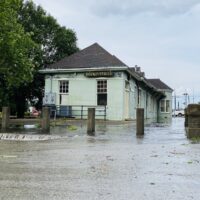Preliminary results show that an experimental “fish fence” installed to block invasive Asian carp from entering Lake Barkley in western Kentucky is effective. A local official who has fought the invasive species for years is touting the initial data as a potential “game-changer.”
The BioAcoustic fish fence — installed along the Cumberland River bottom below Barkley Dam by the U.S. Fish and Wildlife Resources in 2019 — uses a combination of light, sound and bubbles to deter Asian carp from entering into Lake Barkley. Sound is broadcasted to the fish through a “wall of bubbles.”
Data shared last week by the “War on Carp” advocacy group shows 254 fish were tagged and tracked from November 1, 2020, to February 13, 2021. Out of those fish, 57 crossed the barrier when it was turned off; only four crossed the barrier when it was turned on. Additionally, the fish approached the barrier 3,181 times when it was turned off; the fish approached the barrier 612 times when it was turned on.
Lyon County Judge-Executive Wade White, who founded the “War on Carp” group, said he’s using the initial results to push U.S. Senator Mitch McConnell’s office for funding to install additional barriers.
“I think we’ve reversed a lot of the problems that we’ve been seeing. Our tourism is back. There are people that go out on the water and never even see one jump,” White said. “That was unheard of three years ago.”
White says the region is making progress combating Asian carp due to the experimental barrier and local fisherman, who are paid a subsidy to take the invasive carp out of the lakes. Along with the “fish fence,” federal and state officials have tried experimental methods like modified nets to cull Asian carp from the lakes.
Asian carp crowd out native species and disturb the food chain in the lakes, raising worries about the disruption of native habitats.
The fish fence at the Barkley Dam is a part of a three-year trial of the technology.
A spokesperson with Kentucky Department of Fish and Wildlife Resources said federal officials presented the preliminary findings of a fence a couple of months ago.
Liam Niemeyer is a reporter for the Ohio Valley Resource covering agriculture and infrastructure in Ohio, Kentucky and West Virginia and also serves Assistant News Director at WKMS. He has reported for public radio stations across the country from Appalachia to Alaska, most recently as a reporter for WOUB Public Media in Athens, Ohio. He is a recent alumnus of Ohio University and enjoys playing tenor saxophone in various jazz groups.






